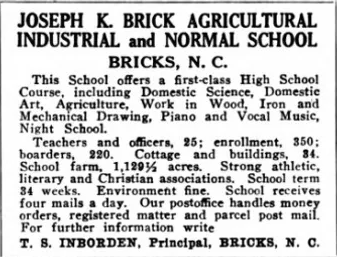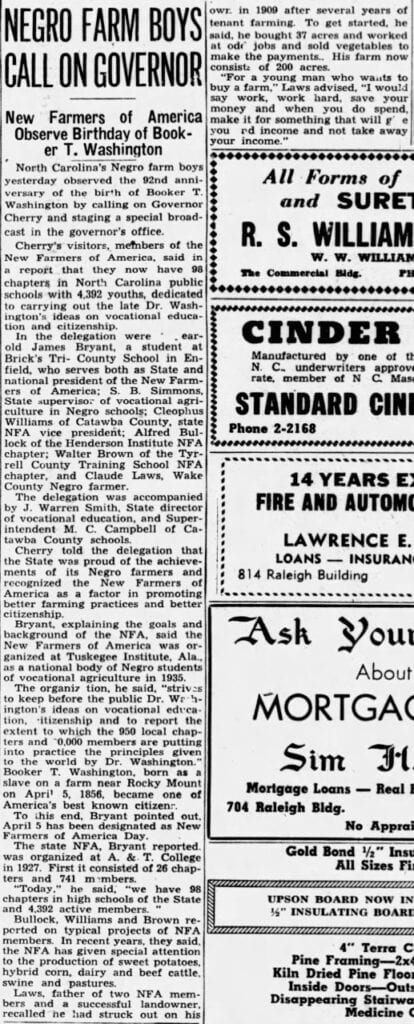If the New Farmers of America (NFA) were still in existence today, last week would have been National NFA Week. To keep the legacy of the NFA alive in our collective memories, the past two Footnotes have focused on the NFA. We will continue in that vein this week with a story about a unique school for African-Americans.
Era 1 – John Keasbey Brick Agricultural, Industrial and Normal School
Our story starts in 1867. During the waning days of the Civil Was General Estes of the Union Army was advancing on Richmond, VA, and passed through Eastern North Carolina. He liked what he saw and decided to return after the war and buy some land, which he did. In 1867 Estes bought the 1,129 acre Wiggins plantation from the Garrett family.
General Estes grew cotton, corn, peaches, strawberries, and other fruits and vegetables. He shipped these goods on a railroad spur that passed through the property. However, he was a better general than he was a farmer. Soon he was immersed in debt. He approached an old friend, Mrs. Joseph Keasbey Brewster Brick of Brooklyn New York for assistance. She loaned him money, but to no avail. Estes could not recover from his debts. Finally, the plantation ended up in the hands of Mrs. Brick.
Mrs. Brick decided she would like the plantation used as “a school for poor colored children who would not be able to attend other schools (Inborden, 1937, p. 4)”. Mrs. Brick was “primarily interested in colored people learning how to do things with their hands (Inborden, 1937, p. 6)”. Her husband, who had died shortly after the Civil War, was a civil engineer and had accumulated considerable wealth with his projects in the South. After exploring ways to make this school dream happen, Mrs. Brick deeded the plantation along with $5,000 to the American Missionary Association in the late 1890s.
In 1895 the American Missionary Association sent five teachers and a principal to a location two miles south of Enfield, North Carolina to start the school. With additional financial support from Mrs. Brick the school grew, both from a facilities standpoint and in student numbers. Starting with one pupil the enrollment grew to 54 in the first year. Initially, it was a primary school then added a high school. The enrollment eventually reached 460 students, of which 260 were boarders who lived in the three dormitories on the campus.

Figure 1. The Campus
The curriculum was both classical and vocational. Agriculture, Domestic Science, and Manual Arts were taught along with liberal arts. Students worked with livestock and crops, in the dining hall, and in the laundry. The philosophies of BOTH Booker T. Washington and W. E. B DuBois were integrated into the curriculum. Because of the farmland, a farm superintendent was hired (a graduate of North Carolina A&T College). At one time the school had 27 plows in operation. In one year, the farm produced 5,000 bushels of peanuts, 125 bales of cotton, 2,000 bushels of potatoes, 5,000 heads of cabbage and 9,000 quarts of canned goods. The school had horses, cows, and mules. They also had 1,000 hens.
The school was commonly known as the Brick School but the official name was The John Keasbey Brick Agricultural, Industrial and Normal School.

Figure 2. Advertisement for the School.
In 1926 the school added a junior college. But shortly thereafter the Great Depression reduced contributions and made it more difficult for students to pay tuition. Also, the state of North Carolina had supported the development of state-supported schools for people of color since the establishment of the Brick School. The School had to close its doors in 1933. It was one of a few Black colleges in the South accredited by the Southern Association of Colleges and Schools at that time.

Figure 3. State Historical Marker.
Era II – Brick Rural Life and Tri-County School
Three years after the Brick School closed it opened again (1936) as an entirely new experiment in agricultural education that involved primary, secondary, and adult education. Three counties in North Carolina (Nash, Halifax, and Edgecombe) converge at the site of the former Brick School. The state of North Carolina and these three counties established a free primary and secondary rural school for Negroes which they called the Brick Tri-County School (or often Brick’s Tri-County School). It was also known as the Brick Rural Life School.

Figure 4. Brick Tri-County School Students
The American Missionary Association granted the free use of buildings on the former Brick campus and assisted in securing buses for the school. They also helped in paying salaries of home economics and vocational agriculture teachers and county-wide agriculture and home demonstration agents (Brownlee, 1938).
Tenant Education
When the original Brick School was still in operation some of the farmland had been leased to tenants. However, there were no special provisions to help or educate them. This was about to change. The thinking of the Brick Rural Life School administration was (Brownlee, 1938, p. 10):
Since the economic pattern of the Brick community is agricultural and since for two generations the Brick Farm has been a tenant farm, we are building our program on those foundations. We believe that there are no short cuts leading to successful farming, and farm ownership and management. We are wide awake to the futility of placing an ignorant and untrained man on a forty acre farm with a good house, barn, out-buildings, implements, mules, cows, and chickens and with forty years to pay for them, and expect him—presto–to become a successful farmer.
The new plan was to continue with the tenant farm system BUT limit the tenant to five years and couple that with education. The county agent and agriculture teacher would work with the tenant farmer. The expectations were (Brownlee, 1938, p. 12)
Each farmer is required to till his land scientifically, fertilize the soil, comply with government restrictions, enter into community and national plans for soil erosion and reforestation, and in all other ways take his full share of social responsibility. He pays a fair rate of rent, the rent being used toward the expenses of the school. He is required to keep an account of all his farm and household receipts and expenditures with the constant thought in mind that he must be getting out of debt with the man in town and start saving for his own farm. His accounts are audited weekly.
After 5 years it was expected the tenant would be a good credit risk because he had a proven track record and would be able to buy his own farm or manage a farm.
The Short Term School
The tenant farmers wanted to learn more faster. Other farmers in the community who were not tenants on school property also wanted to be educated. So, a Short Term School was established. The school was held during January and February when work on the farm is slack. Here is how Greenlee described the school (1938, p. 13):
It is conducted for adults (above the age of eighteen), who wish to benefit by the “Brick” idea. The tenants on the Brick farm attend, together with other landowning or tenant farmers, and their sons and daughters. These folk, married and unmarried, come to live at the school for a period of six weeks. Of
What the farmer should get for his cotton, tobacco and peanuts, or what he might grow to better advantage are of basic concern. How he may avoid the loan shark, manage his farm economically and systematically; produce, raise, and market chickens and hogs successfully, and how far it pays to go with cows; how a farmer may keep his own buildings and implements in repair at great savings in time and moneys-all these and many more equally pertinent and practical questions for farmers are discussed.
The women learned about household arts and home management. There were also recreational and social activities planned for the short-term school attendees.

Figure 5. Attendees from the first Short-Term School
Brick Tri-County School
The high school curriculum included vocational agriculture and included a New Farmers of America chapter. The NFA chapter operated a poultry cooperative and a cooperative bull association (See Figure 6).

Figure 6. Clipping from the Rocky Mount Telegram (NC), January 25, 1939.
Apparently, the agriculture program was excellent. The Rocky Mount (NC) Telegram reported (January 15, 1941) the Hampton Institute had been sending 1-2 student teachers a year for several years to do their student teaching at Brick Tri-County. The student teacher in the spring of 1941 was to teach all-day classes, teach adult classes, and work with the rural life school and community on agricultural issues.
A Leadership Training Camp held by the North Carolina Chapter of the New Farmers of America was conducted on the campus of Brick Tri-County School in the late 1930s. About one hundred and twenty-five Vocational Agriculture students and teachers participated in this camp.
During NFA week in 1948, a delegation of NFA members visited the Governor of North Carolina. Among the delegates was James Bryant from Brick’s Tri-County School. Bryant also happened to be the state and national president of the NFA. See the clipping below.

Figure 7. Clipping from the Raleigh (NC) News and Observer. April 6, 1948.
The Brick’s Tri-County School eventually closed due to school consolidations and the integration of schools in North Carolina.
Concluding Remarks
Farm visits were a valuable teaching tool at Brick. On one such visit, a farmer who just a week before had been able to free himself from a local loan shark with the knowledge he had gained from the tenant farmer program stated (Brownlee, 1938, p. 17) “It’s as if life had started all over again.”
For many Black farmers, the knowledge and skills they learned at Brick did help them start life over again. It helped free them from the unscrupulous landlords and merchants. The agricultural agents and teachers played a major role in their emancipation.
And for the high school agricultural students, the knowledge they gained from their agriculture teacher and the leadership skills they learned in the NFA, gave them a head start on life.
The selfless act of Mrs. Brick started a chain reaction of good that benefitted innumerable people over many decades. We can have the same effect through our teaching and community service.
References
Brick Junior College. https://www.lostcolleges.com/brick-junior-college.
Brownlee, F. L. (1938). Brick Rural Life School, Bricks, North Carolina. https://hdl.handle.net/2027/nc01.ark:/13960/t3pv83p2n
Inborden, T. S. (1937). History of Brick School. https://franklintoncenteratbricks.org/wp-content/uploads/2019/07/History-Of-Brick-School.pdf
Men of the Soil: The Story of Brick Rural Life School. http://divinityarchive.com/bitstream/handle/11258/8917/menofsoilstoryof00mort_0.pdf?sequence=1
There is a 36-minute long video about the Brick School. https://www.youtube.com/watch?v=nr3Uyw76NuY
